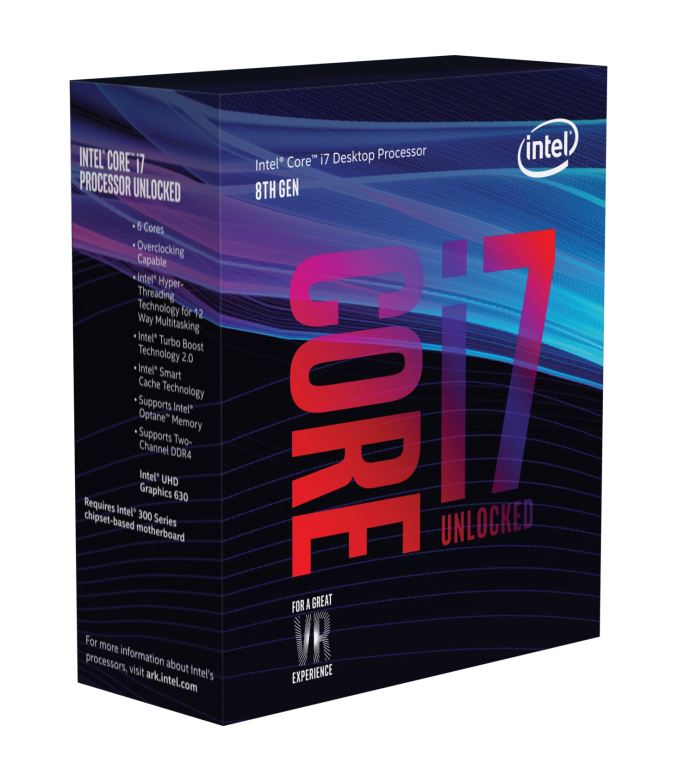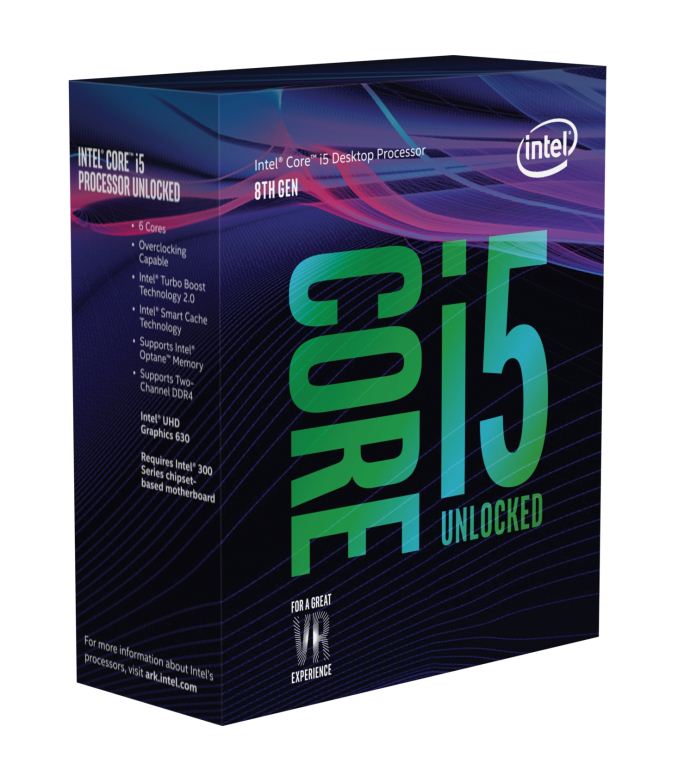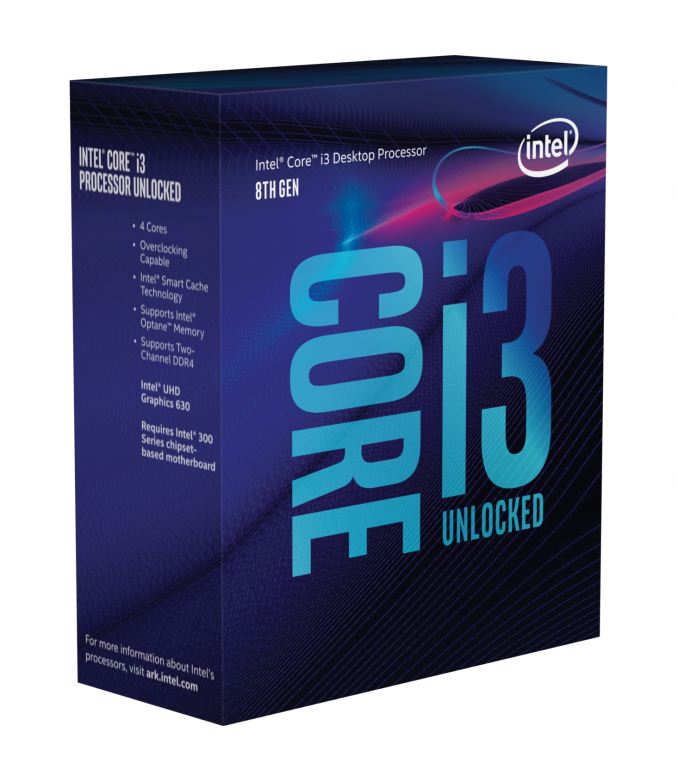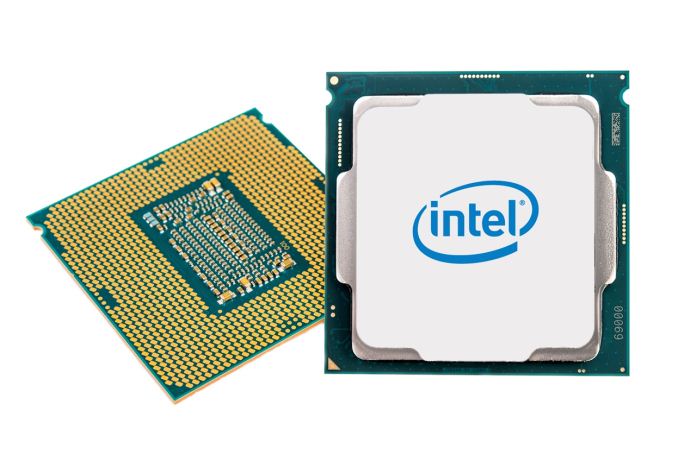The AnandTech Coffee Lake Review: Initial Numbers on the Core i7-8700K and Core i5-8400
by Ian Cutress on October 5, 2017 9:00 AM EST- Posted in
- CPUs
- Intel
- Core i5
- Core i7
- Core i3
- 14nm
- Coffee Lake
- 14++
- Hex-Core
- Hyperthreading
Intel Coffee Lake Conclusion
It has been a long time coming, but we finally have something bigger than a quad-core processor on Intel’s mainstream platform. Fundamentally it might be the same architecture as the processors preceded it, but after a decade of quad-core Intel parts, it comes as a welcome improvement. Intel sampled us the Core i7-8700K and the Core i5-8400 for this set of initial launch testing, with the goal of offering more high performance cores at more mainstream price points without having to invest in the company's more expensive and otherwise more complex HEDT platforms.
The Core i7-8700K
The Core i7-8700K in our testing was designed to be the new halo mainstream processor: many cores and the highest frequencies seen on an Intel part out of the box, with the option of overclocking thrown in. With a peak turbo frequency of 4.7 GHz, in benchmarks that could be stripped down to a single core with no other work going on, the i7-8700K took home the bacon.
The problem here is the same problem we’ve seen with big core parts and Windows 10, however: these large processors can only take so much before having to move threads around, to keep both the frequency high and the energy density low. All it takes is for a minor internal OS blip and single-threaded performance begins to diminish. Windows 10 famously kicks in a few unwanted instruction streams when you are not looking, and as a result the CPU fires up another CPU core and drops to a lower turbo bin. Consequently the average single thread performance seen on the 8700K might be equal or lower than that of the previous generation. It becomes an infuriating problem to debug as a reviewer.
Nonetheless, when software needs to take advantage of the cores, the Core i7-8700K will run through at an all-core turbo frequency of 4.3 GHz, consuming about 86W in the process. The jump up from a quad-core to a hex-core for only a $20 difference will be immediately noticeable in the software that can take advantage of it.
What is interesting to note is that the Core i7-8700K essentially kills the short-lived Kaby Lake-X parts on the X299 high-end desktop platform. Again, for a few extra dollars on the 8700K, a user can save over $100 on the motherboard, get more cores and more performance, and not have the hassle of dealing with a hybrid X299 platform. It does make me wonder why Intel released Kaby Lake-X in the first place, if they knew just how short lived they would be.
When comparing against the Core i7-7800X, a high-end desktop part at a similar price and with the same core count but a lower frequency, it really comes down to what the user needs. Performance easily favors the Core i7-8700K, however that cannot replace the quad-channel memory (up to 128GB) and the 28 PCIe lanes that the Core i7-7800X can support. In most circumstances, especially gaming, the Core i7-8700K will win out.
Intel’s 8th Generation CPUs: The Ones To Watch
Intel also sampled us the Core i5-8400, showing that six-core processors can cost less than $200. This processor, along with the Core i3-8100, will form the new backbone of general computing when using Intel components: the Core i3-8100 replaces old Core i5 processors for around $120, and enthusiasts who simply want a little more oomph can go with the Core i5-8400 at $190 at retail. It almost comes across as adding 50% cost for adding 50% performance. Personally I think the Core i3-8100, if made widely available, will be a top-selling processor for casual desktop users and gamers who were previously looking for a good performance-per-dollar part.
There is one other comparison to note: the Core i5-8600K and the Core i7-8700. These two parts are $50 apart, however the Core i7-8700 has double the threads, +10% raw frequency, 33% more L3 cache, and 1/3 lower TDP. The Core i5-8600K has overclocking, however going up to the i7 ensures stability, and should offer more raw performance. It will be interesting to get these two in to test, and especially to see if the TDP rating makes a significant performance difference.
Today’s Review Takeaway
We finally have six-core processors on Intel’s mainstream platform, which has driven up the core counts (and frequencies) of the company's low and mid-range processors. For anyone looking at building a system in the last 6-12 months, they should be able to build an equivalent with the latest-generation processor for $50-$100 less. Or spend the same and get a few more cores to play with. The last time we had this situation was a decade ago, and hopefully it won’t take another decade to happen again.
Dedicated reviews for the processors (with more gaming tests) are on the cards. Stay tuned!















222 Comments
View All Comments
FireSnake - Thursday, October 5, 2017 - link
Awesome revies! Let's read...prisonerX - Thursday, October 5, 2017 - link
No need, here is a quick summary: "Intel blind panic."StevoLincolnite - Thursday, October 5, 2017 - link
At-least they have finally soundly beat my 3930K in the mainstream after 6 years.Still. No point me upgrading just yet.
mapesdhs - Friday, October 6, 2017 - link
Even then there's an interesting option if you want threaded performance; I just upgraded to a XEON E5-2680 v2 (IB-EP) for 165 UKP. Lower 1T speed for sure, but MT should be the same or better as a 3930K @ 4.8. No oc means more stable, less heat/noise/power, and being IB-based means it ups the slots to PCIe 3.0. Not a relevant choice for gaming, but a possibility for those doing VMs, rendering, etc., and just want to get by for a little while longer.Breit - Friday, October 6, 2017 - link
OR search for an XEON E5-1680v2... :)It's an Ivy Bridge-E 8c/16t chip that will fit in Sandy Bridge-E mainboards (x79) and has an unlocked multiplier opposed to this E5-2680v2. So with this you won't lose your overclocking ability.
But in the end, I guess that the greatly reduced power draw and the more "modern" platform from an i7-8700K system compared to the x79 platform will give it the edge here.
mapesdhs - Monday, October 9, 2017 - link
Very interesting that the 1680 v2 is unlocked, I didn't know that.Alas though, availability of the 1680 v2 is basically zero, whereas the 2680 v2 is very easy to find, and the cost of 1680 v2s which are available (outside the UK) is extremely high (typical BIN of 600 UKP, normal auction start price of 350 UKP, completed listings only shown for BIN items which were purchased for between 500 and 600 UKP). By contrast, I bought several 2680 v2s for 165 UKP each. Testing on a P9X79 WS (all-core turbo of 3.1) gives a very impressive 15.44 for CB 11.5, and 1381 for CB R15 which is faster than a stock 8700K (for reference, the 1680 v2 scores 1230 for CB R15). Note the following page on AT has a very handy summary of all the turbo bin levels:
https://www.anandtech.com/show/7852/intel-xeon-e52...
So, I'm very pleased with the 2680 v2 purchase, it's faster than my 3930K @ 4.8, runs with very low temps, much lower power draw, hence less heat, less fan noise and since it's not oc'd it'll be solidly reliable (this particular test system will eventually be in an office in India, so power/heat/reliability is critical). For the target systems in question, it's a great solution. Only thing I noticed so far is it didn't like me trying to set a 2133 RAM speed, but it worked ok at 1866; I can probably tighten the timings instead, currently just at 9/11/10/28/2T (GSkill 32GB kit, 8x4GB).
The 4930K I have though will go into my gaming system (R4E), since I don't mind the oc'ing fun, higher noise, etc., but it's not a system I'll use for converting video, for that I have a 6850K.
Ian.
MrSpadge - Friday, October 6, 2017 - link
Full throttle: yes. Panic: no. Blind: no.Zingam - Saturday, October 7, 2017 - link
Can you buy it? No? Paper launch of Unobtanium 8000? -> panic, PR propaganda bullshit and dirty Intel marketing tactics as usual targeted at lamer fanboys.This comment is written by an Intel user! ;)
prisonerX - Saturday, October 7, 2017 - link
We've got enough dumb Intel apologists here already, thanks.coolhardware - Sunday, October 8, 2017 - link
The i7-8700 is *finally* going to replace my trusty i5-2500K.Ordered my 8700 on Amazon http://amzn.to/2y9IamG ($319) and looking forward to a nice upgrade :-) That is a lot of CPU for the money IMHO.
Kudos to AMD for bringing competition back to the CPU market!